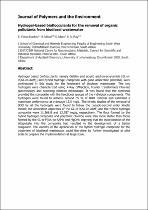 ResearchSpace
ResearchSpace
Hydrogel-based bioflocculants for the removal of organic pollutants from biodiesel wastewater
JavaScript is disabled for your browser. Some features of this site may not work without it.
- ResearchSpace
- →
- Research Publications/Outputs
- →
- Journal Articles
- →
- View Item
| dc.contributor.author |
Fosso-Kankeu, E

|
|
| dc.contributor.author |
Mittal, Hemant

|
|
| dc.contributor.author |
Marx, S

|
|
| dc.contributor.author |
Ray, Suprakas S

|
|
| dc.date.accessioned | 2018-05-23T07:23:21Z | |
| dc.date.available | 2018-05-23T07:23:21Z | |
| dc.date.issued | 2017-09 | |
| dc.identifier.citation | Fosso-Kankeu, E., Mittal, H., Marx, S. and Ray, S.S. 2017. Hydrogel-based bioflocculants for the removal of organic pollutants from biodiesel wastewater. Journal of Polymers and the Environment, vol 25(3), pp 844–853 | en_US |
| dc.identifier.issn | 1566-2543 | |
| dc.identifier.uri | https://link.springer.com/article/10.1007/s10924-016-0870-8 | |
| dc.identifier.uri | http://hdl.handle.net/10204/10233 | |
| dc.description | Copyright: 2017. Springer Verlag. Due to copyright restrictions, the attached PDF file only contains the abstract of the full text item. For access to the full text item, please consult the publisher's website. The definitive version of the work is published in Journal of Polymers and the Environment, vol 25(3), pp 844–853 | en_US |
| dc.description.abstract | Hydrogel based bioflocculants namely Gelatin and acrylic acid-co-acrylamide [GL-cl-P(AA-co-AAM)] and hybrid hydrogel composite with good adsorption potential, were synthesized in this study for the treatment of biodiesel wastewater. The two hydrogels were characterized using X-Ray diffraction, Fourier transformed infra-red spectroscopy and scanning electron microscope. It was found that the synthesis provided the composite with the functional groups of the individual components. The hydrogels were found to achieve around 65 % of BOD removal and exhibited a maximum performance at a dosage 12.5 mg/L. The kinetic studies of the removal of BOD by all the hydrogels were found to follow the pseudo-second order kinetic model; the adsorption capacities of the GL-cl-P(AA-co-AAM) and the hybrid hydrogel composite were 11,368.8 and 12,787 mg/g, respectively. The flocs formed by the hybrid hydrogel composite and polyferric chloride were also more stable than those formed by the GL-cl-P(AA-co-AAM) and MgOH; implying that the incorporation of the attapulgite into the composite had resulted in the development of a better coagulant. The viability of the application of the hybrid hydrogel composite for the treatment of biodiesel wastewater could therefore be further investigated at pilot scale to prepare the implementation at large scale. | en_US |
| dc.language.iso | en | en_US |
| dc.publisher | Springer Verlag | en_US |
| dc.relation.ispartofseries | Workflow;20235 | |
| dc.subject | Biodiesel wastewater | en_US |
| dc.subject | Bioflocculants | en_US |
| dc.subject | Flocculation | en_US |
| dc.subject | Hydrogels | en_US |
| dc.subject | Inorganic coagulants | en_US |
| dc.title | Hydrogel-based bioflocculants for the removal of organic pollutants from biodiesel wastewater | en_US |
| dc.type | Article | en_US |
| dc.identifier.apacitation | Fosso-Kankeu, E., Mittal, H., Marx, S., & Ray, S. S. (2017). Hydrogel-based bioflocculants for the removal of organic pollutants from biodiesel wastewater. http://hdl.handle.net/10204/10233 | en_ZA |
| dc.identifier.chicagocitation | Fosso-Kankeu, E, Hemant Mittal, S Marx, and Suprakas S Ray "Hydrogel-based bioflocculants for the removal of organic pollutants from biodiesel wastewater." (2017) http://hdl.handle.net/10204/10233 | en_ZA |
| dc.identifier.vancouvercitation | Fosso-Kankeu E, Mittal H, Marx S, Ray SS. Hydrogel-based bioflocculants for the removal of organic pollutants from biodiesel wastewater. 2017; http://hdl.handle.net/10204/10233. | en_ZA |
| dc.identifier.ris | TY - Article AU - Fosso-Kankeu, E AU - Mittal, Hemant AU - Marx, S AU - Ray, Suprakas S AB - Hydrogel based bioflocculants namely Gelatin and acrylic acid-co-acrylamide [GL-cl-P(AA-co-AAM)] and hybrid hydrogel composite with good adsorption potential, were synthesized in this study for the treatment of biodiesel wastewater. The two hydrogels were characterized using X-Ray diffraction, Fourier transformed infra-red spectroscopy and scanning electron microscope. It was found that the synthesis provided the composite with the functional groups of the individual components. The hydrogels were found to achieve around 65 % of BOD removal and exhibited a maximum performance at a dosage 12.5 mg/L. The kinetic studies of the removal of BOD by all the hydrogels were found to follow the pseudo-second order kinetic model; the adsorption capacities of the GL-cl-P(AA-co-AAM) and the hybrid hydrogel composite were 11,368.8 and 12,787 mg/g, respectively. The flocs formed by the hybrid hydrogel composite and polyferric chloride were also more stable than those formed by the GL-cl-P(AA-co-AAM) and MgOH; implying that the incorporation of the attapulgite into the composite had resulted in the development of a better coagulant. The viability of the application of the hybrid hydrogel composite for the treatment of biodiesel wastewater could therefore be further investigated at pilot scale to prepare the implementation at large scale. DA - 2017-09 DB - ResearchSpace DP - CSIR KW - Biodiesel wastewater KW - Bioflocculants KW - Flocculation KW - Hydrogels KW - Inorganic coagulants LK - https://researchspace.csir.co.za PY - 2017 SM - 1566-2543 T1 - Hydrogel-based bioflocculants for the removal of organic pollutants from biodiesel wastewater TI - Hydrogel-based bioflocculants for the removal of organic pollutants from biodiesel wastewater UR - http://hdl.handle.net/10204/10233 ER - | en_ZA |





